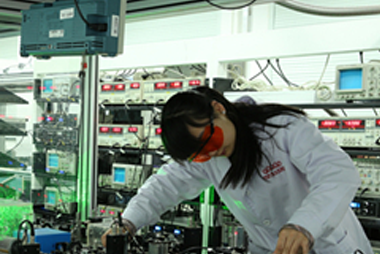
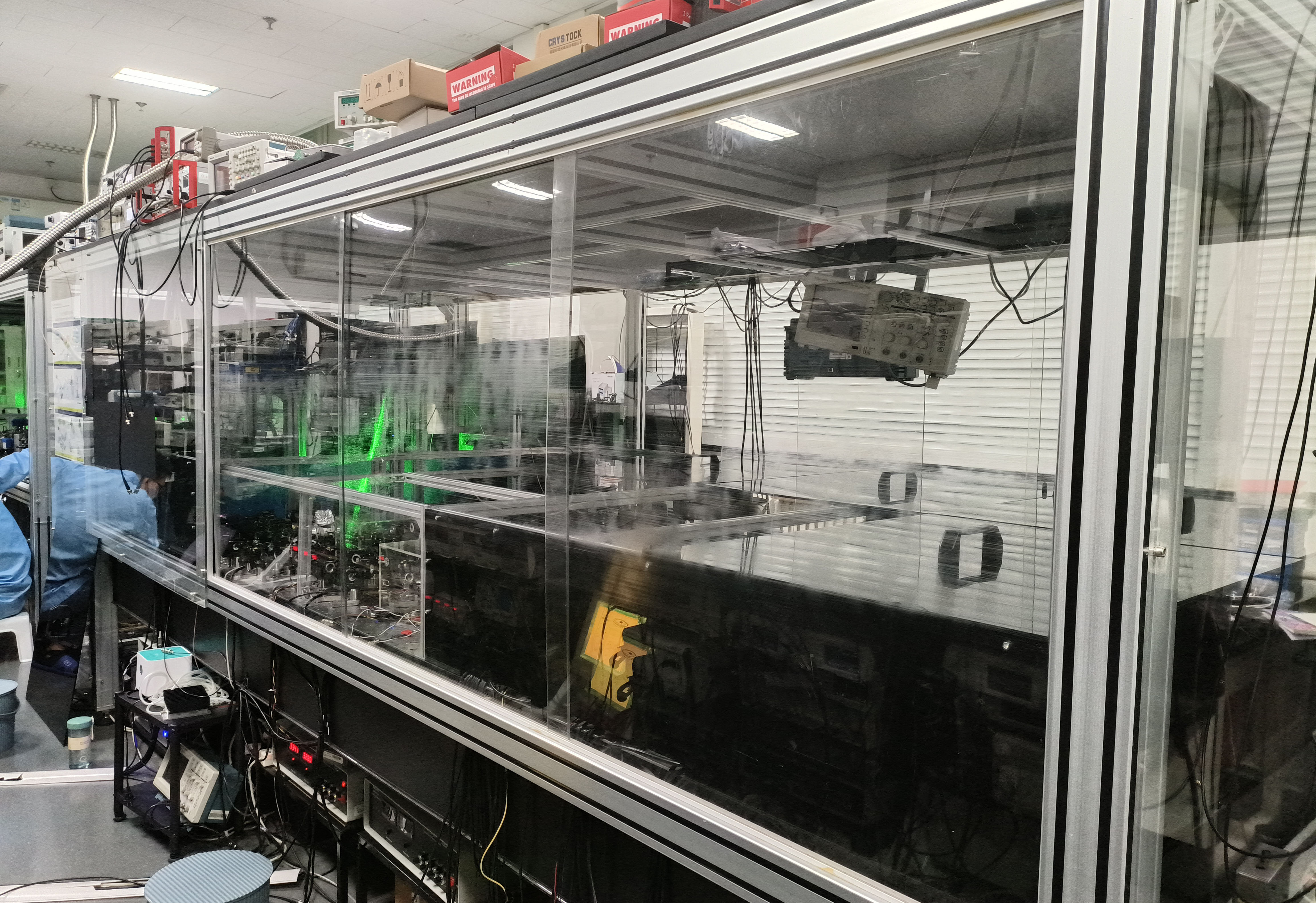

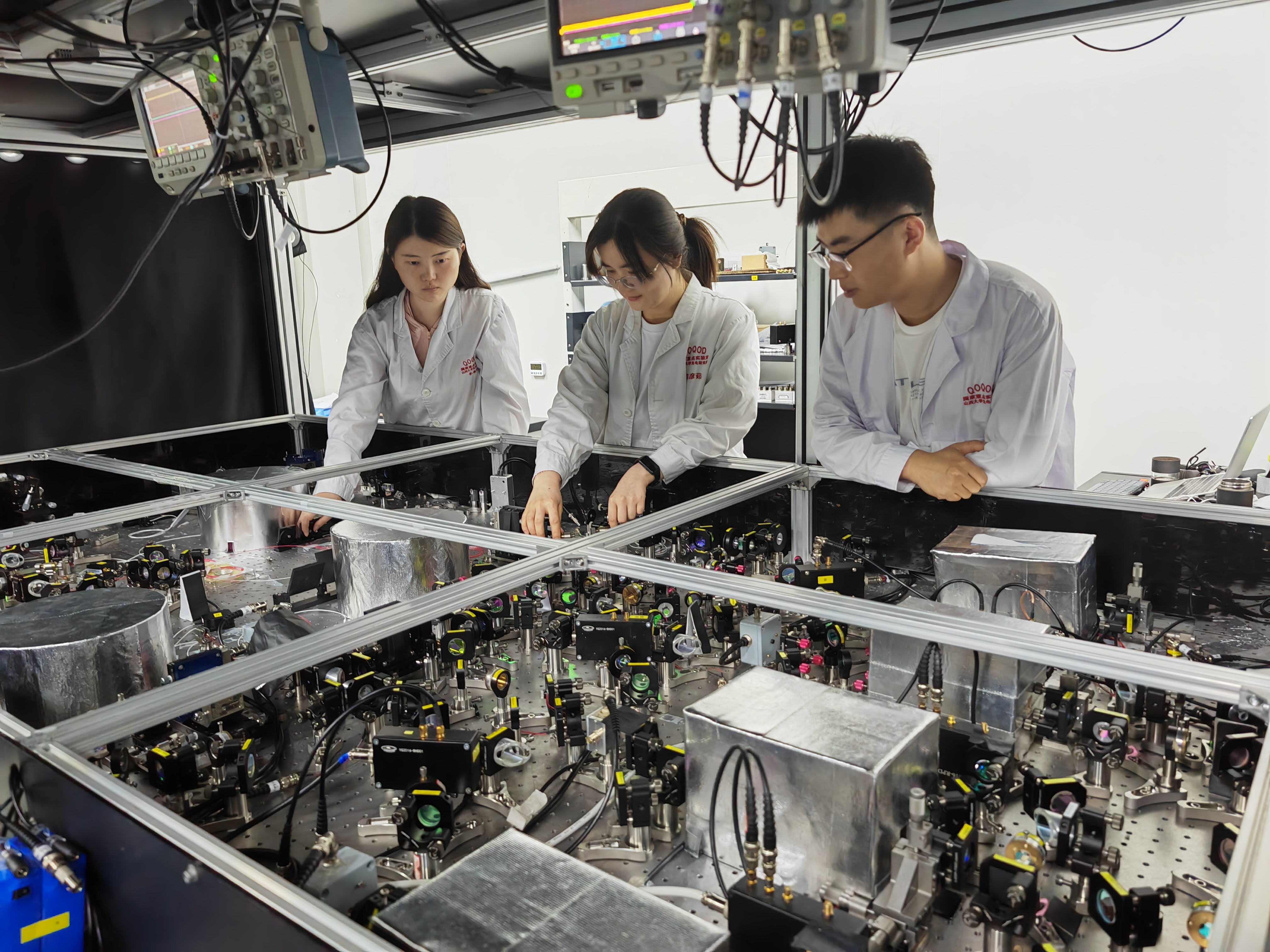

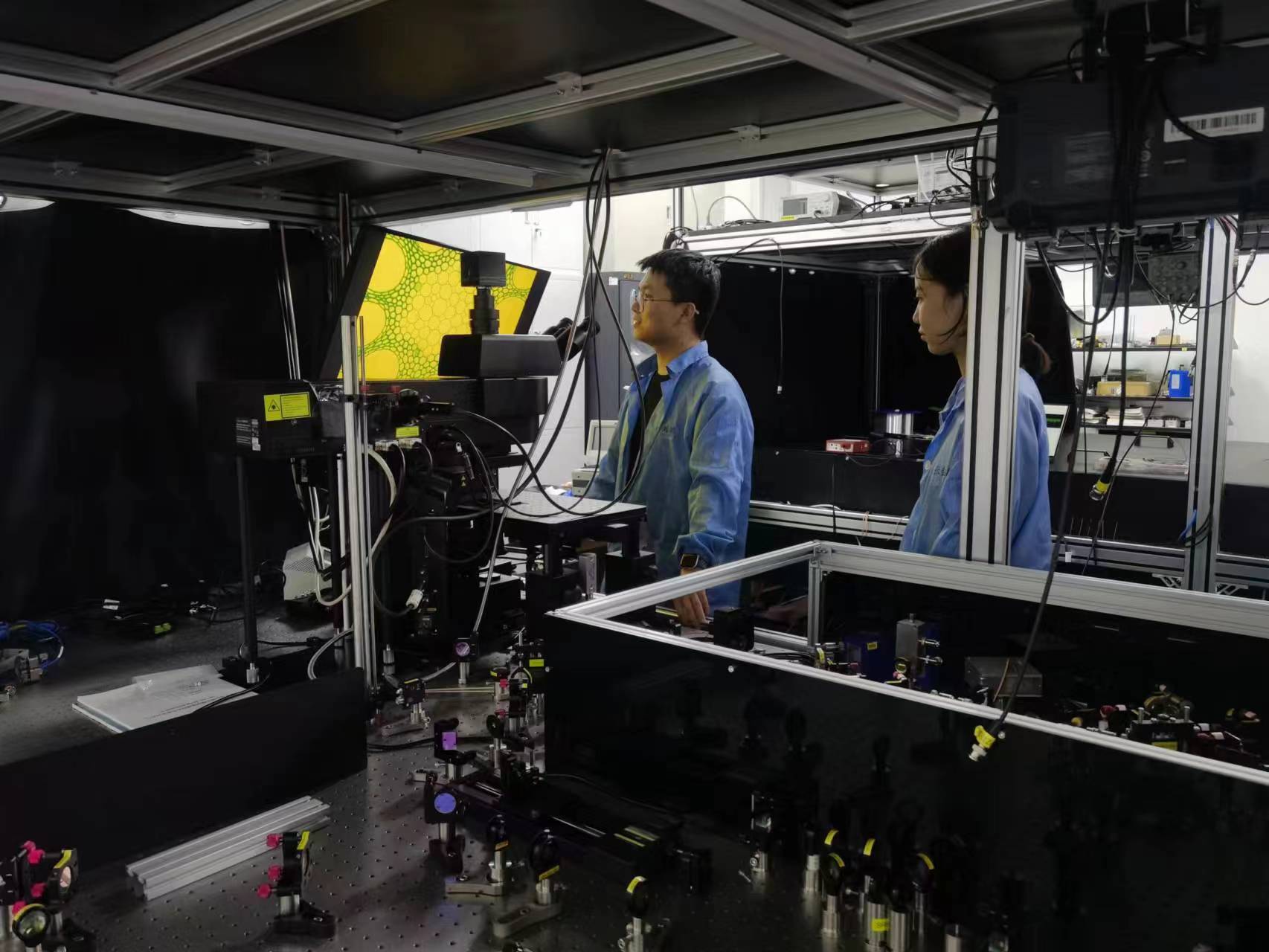
Based on the coherence and quantum property of light, quantum optics studies various non classical effects of light field and quantum phenomena of interaction between light and matter by using quantum mechanics theory and modern optical and electronic experimental means.
Through nondegenerate optical parametric oscillation and amplification, we have obtained the orthogonal two mode squeezed vacuum state, intensity differential pressure squeezed state, bright quantum correlated EPR entangled beam pair, three component entangled state light field, four component GHz like entangled state light field, cluster like entangled state light field, TTPC entangled state light field, eight component cluster entangled state light field, etc. Quantum entanglement swapping, quantum secure communication with continuous variables, quantum controlled not gate, quantum logic gate sequence and so on. Now we are carrying out the research on continuous variable one-way quantum computation and quantum network.
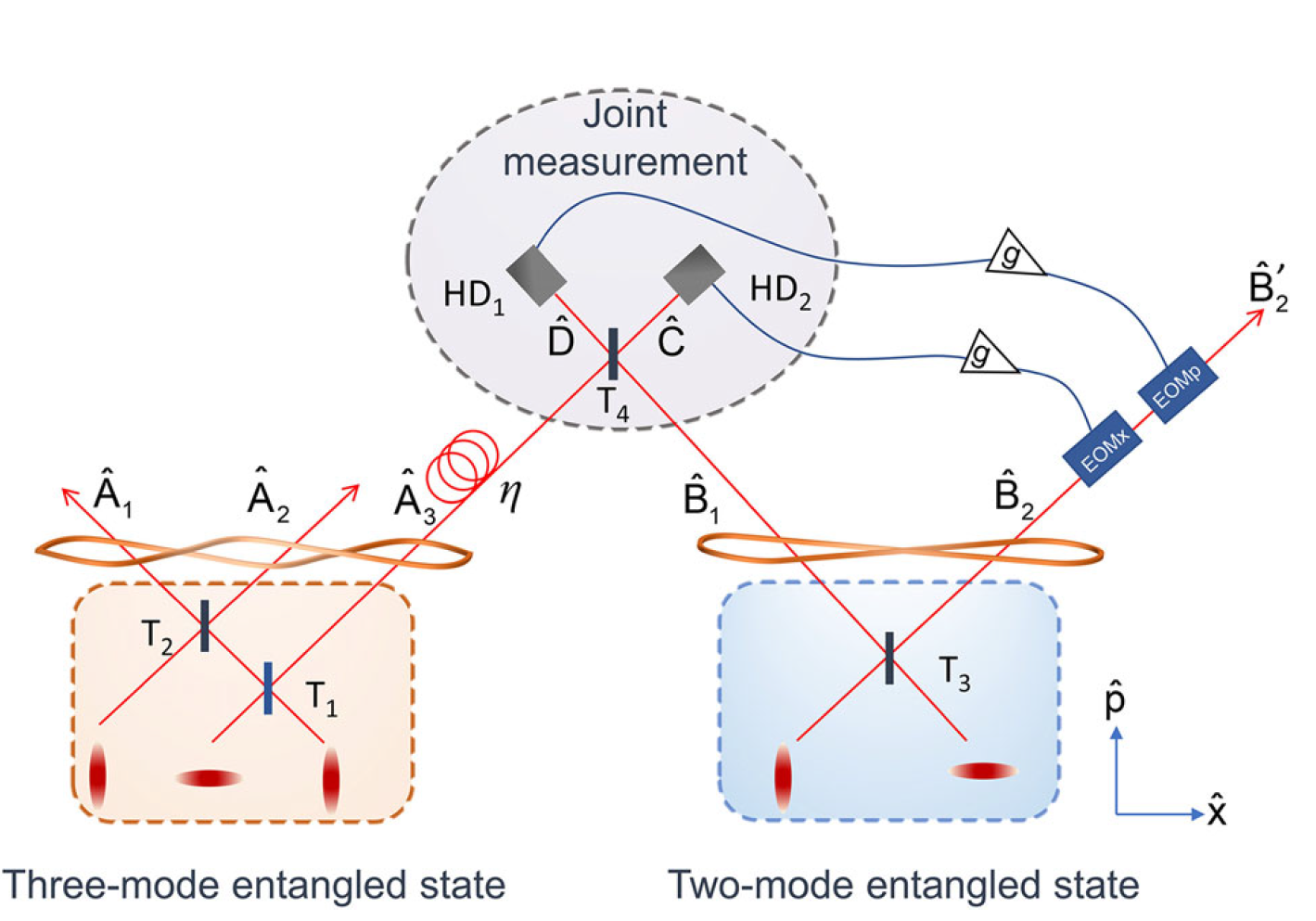
Experimental Demonstration of Quantum Steering Swapping with Gaussian Entangled States
Authors:Na Wang, Meihong Wang, Caixing Tian, Xiaowei Deng, and Xiaolong Su
As a key element in quantum repeaters, entanglement swapping establishes entanglement between two independent entangled states. Besides entanglement, quantum steering has been identified as an essential quantum resource and has broad applications in quantum communication. Although entanglement swapping has been realized experimentally, quantum steering swapping still remains a challenge since the condition of quantum steering is stronger than that of entanglement. In this article, quantum steering swapping between a three-mode and a two-mode Gaussian entangled state in a lossy channel is demonstrated. By choosing the optimum gain in the classical channel that corresponds to the maximum transmission distance, the one-way and two-way steerabilities in a new three-mode Gaussian state located in distant nodes are achieved. The obtained collective steerability from two users to one user has potential application in quantum secret sharing. The results make a crucial step toward applications of quantum steering in asymmetric quantum information processing.
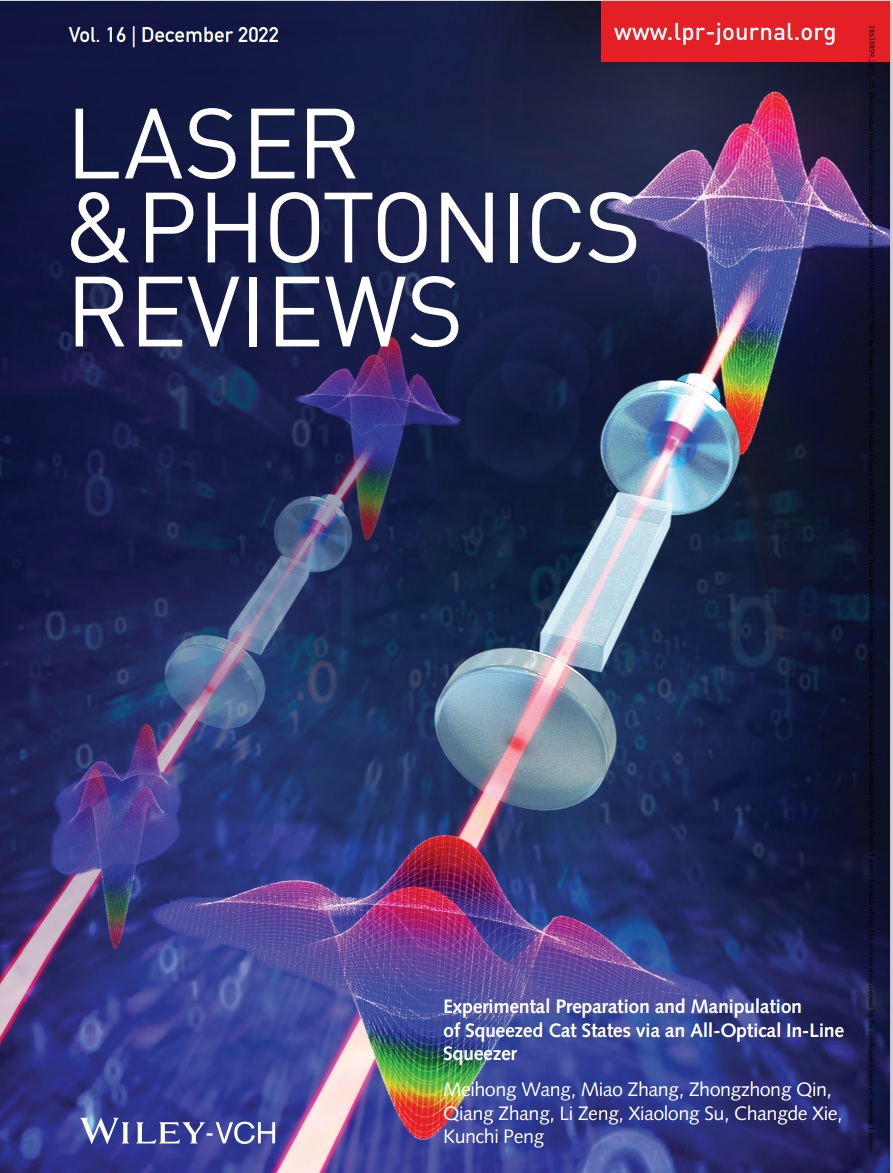
Experimental Preparation and Manipulation of Squeezed Cat States via an All-Optical In-Line Squeezer
Authors:Meihong Wang, Miao Zhang, Zhongzhong Qin,* Qiang Zhang, Li Zeng, Xiaolong Su,* Changde Xie, and Kunchi Peng
The squeezed cat state, an essential quantum resource, can be used for quantum error correction and slowing decoherence of the optical cat state. However, preparing a squeezed cat state with high generation rate, and effectively manipulating it, remain challenging. In this work, a high-performance all-optical in-line squeezer is developed to prepare a squeezed cat state and manipulate the phase of the quadrature squeezing. This scheme has the advantages that the phase of the quadrature squeezing of the squeezed cat state can be manipulated by changing the working condition of the squeezer, and that a higher generation rate can be achieved via the deterministic squeezing operation of the in-line squeezer. The generation rate of squeezed cat states reaches 2 kHz, the same as that of the initial cat state. The all-optical in-line squeezer proposed here removes the requirements of electro-optic and opto-electric conversions necessary for an off-line squeezer, thus enabling high-bandwidth squeezing operations on non-Gaussian states. These results provide an efficient method to prepare and manipulate optical squeezed cat states, which makes a step closer to their applications in all-optical quantum information processing.
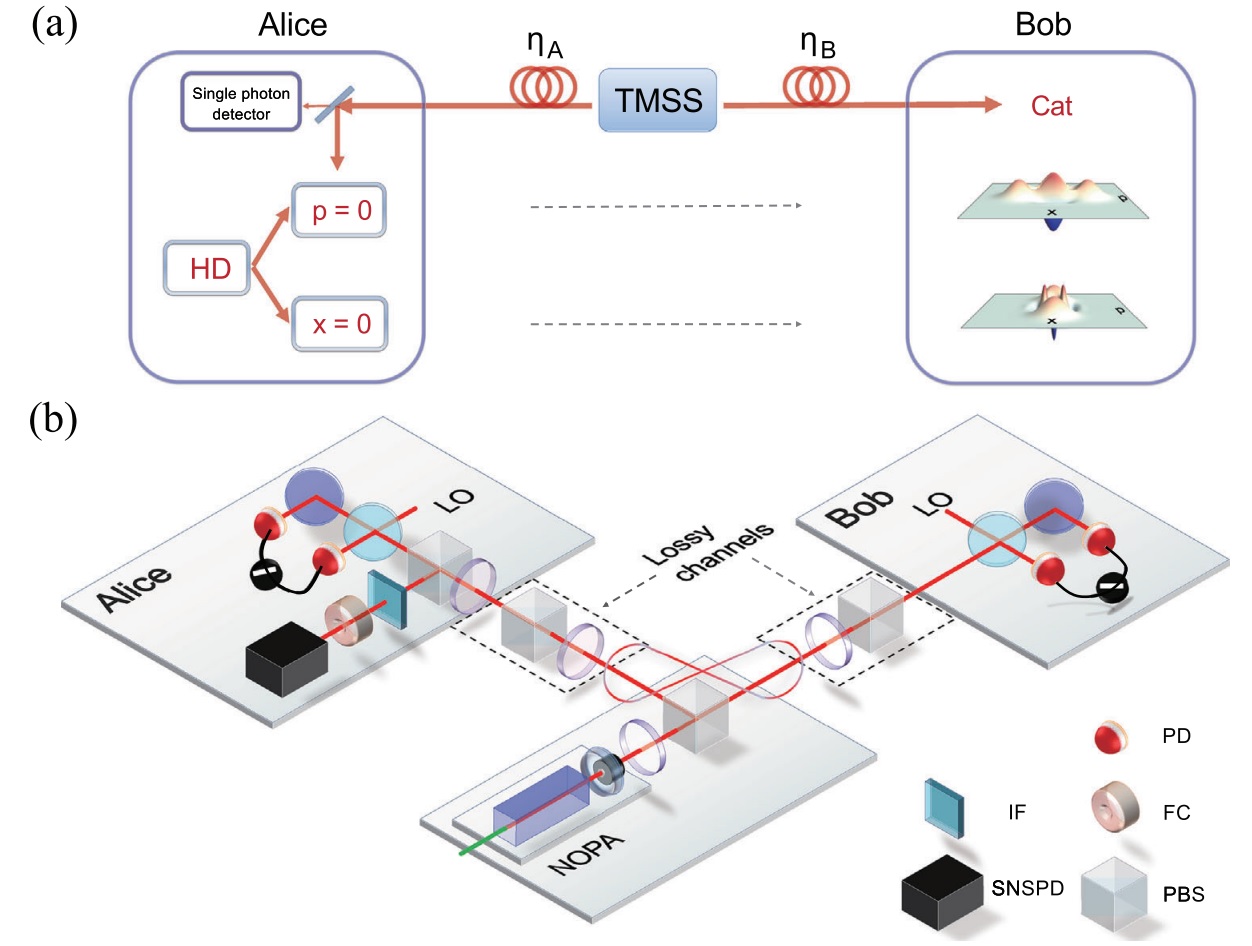
Remote Preparation of Optical Cat States Based on Gaussian Entanglement
Authors:Dongmei Han, Fengxiao Sun, Na Wang, Yu Xiang, Meihong Wang, Mingsheng Tian, Qiongyi He and Xiaolong Su
Remote state preparation enables one to prepare and manipulate quantum state non-locally. As an essential quantum resource, optical cat state is usually prepared locally by subtracting photons from a squeezed vacuum state. For remote quantum information processing, it is essential to prepare and manipulate optical cat states remotely based on Gaussian entanglement, which remains a challenge. Here, experimental preparation of optical cat states based on a remotely distributed two-mode Gaussian entangled state in a lossy channel is presented. By performing photon subtraction and homodyne projective measurement at Alice’s station, an optical cat state is prepared remotely at Bob’s station. Furthermore, the prepared cat state is rotated by changing Alice’s measurement basis of homodyne detection, which demonstrates the remote manipulation of it. By distributing two modes of the two-mode Gaussian entangled state in lossy channels, it is demonstrated that the remotely prepared cat state can tolerate much more loss in Alice’s channel than that in Bob’s channel. It is also shown that cat states with amplitudes larger than 2 can be prepared by increasing the squeezing level and subtracting photon numbers. The results make a crucial step toward remote hybrid quantum information processing involving discrete- and continuous-variable techniques.
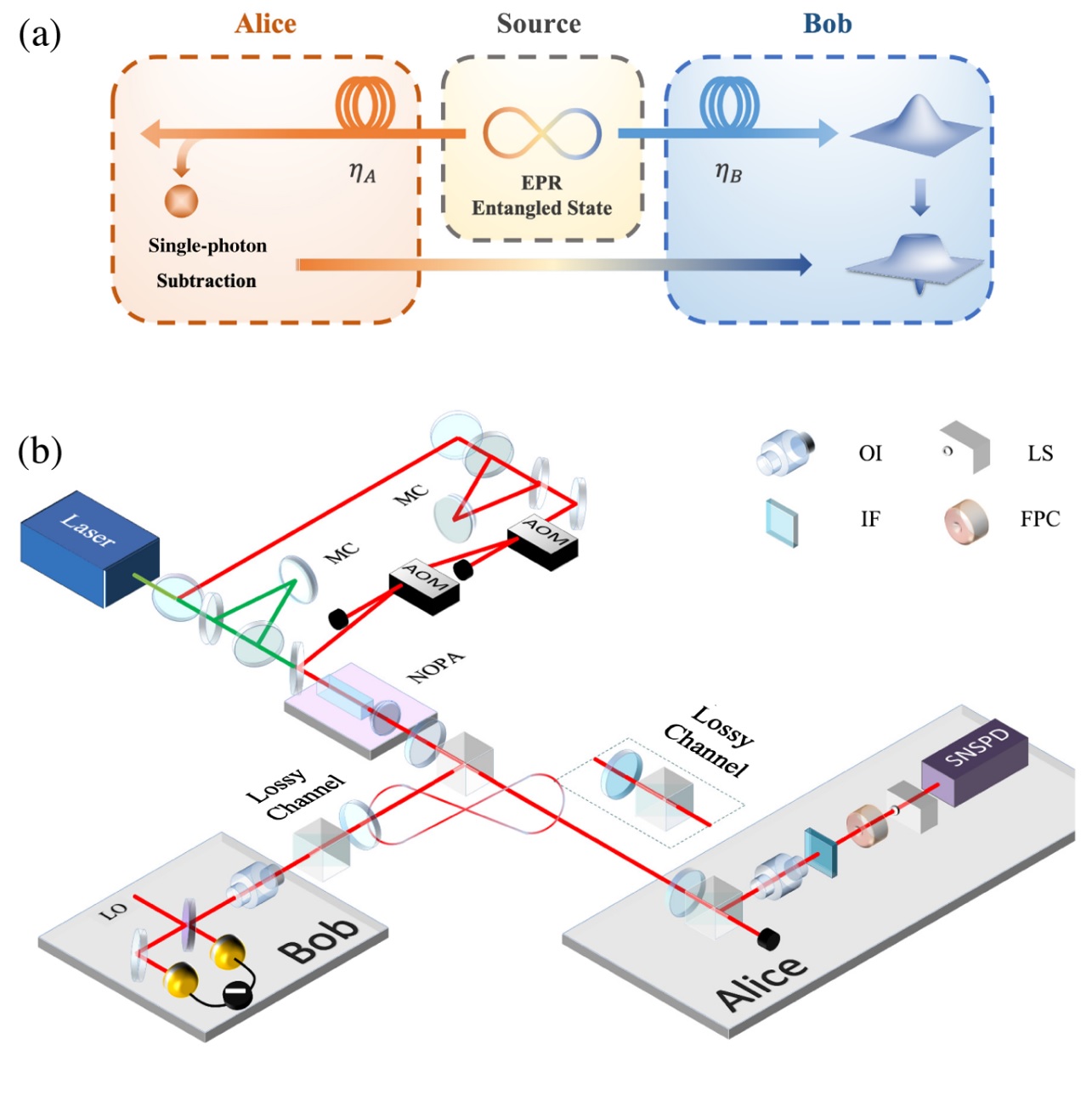
Experimental Demonstration of Remotely Creating Wigner Negativity via Quantum Steering
Authors:Shuheng Liu, Dongmei Han, Na Wang, Yu Xiang, Fengxiao Sun, Meihong Wang, Zhongzhong Qin, Qihuang Gong, Xiaolong Su, and Qiongyi He
Non-Gaussian states with Wigner negativity are of particular interest in quantum technology due to their potential applications in quantum computing and quantum metrology. However, how to create such states at a remote location remains a challenge, which is important for efficiently distributing quantum resource between distant nodes in a network. Here, we experimentally prepare an optical non-Gaussian state with negative Wigner function at a remote node via local non-Gaussian operation and shared Gaussian entangled state existing quantum steering. By performing photon subtraction on one mode, Wigner negativity is created in the remote target mode. We show that the Wigner negativity is sensitive to loss on the target mode, but robust to loss on the mode performing photon subtraction. This experiment confirms the connection between the remotely created Wigner negativity and quantum steering. As an application, we present that the generated non-Gaussian state exhibits metrological power in quantum phase estimation.
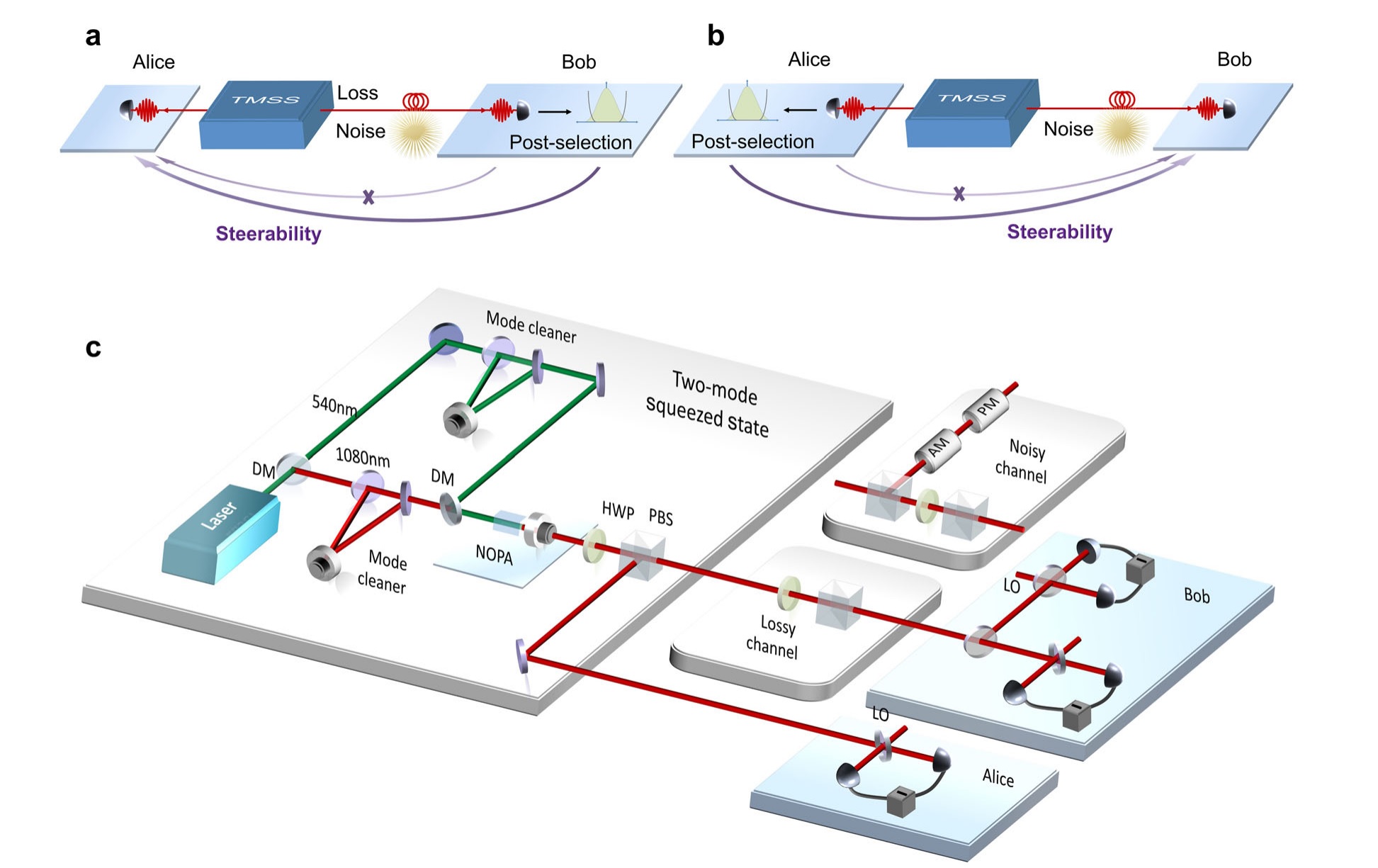
Distillation of Gaussian Einstein-Podolsky-Rosen steering with noiseless linear amplification
Authors:Yang Liu, Kaimin Zheng, Haijun Kang, Dongmei Han, Meihong Wang, Lijian Zhang, Xiaolong Su and Kunchi Peng
Einstein–Podolsky–Rosen (EPR) steering is one of the most intriguing features of quantum mechanics and an important resource for quantum communication. For practical applications, it remains a challenge to protect EPR steering from decoherence due to its intrinsic difference from entanglement. Here, we experimentally demonstrate the distillation of Gaussian EPR steering and entanglement in lossy and noisy environments using measurement-based noiseless linear amplification. Different from entanglement distillation, the extension of steerable region happens in the distillation of EPR steering, besides the enhancement of steerabilities. We demonstrate that the two-way or one-way steerable region is extended after the distillation of EPR steering when the NLA is implemented based on Bob’s or Alice’s measurement results. We also show that the NLA helps to extract the secret key from the insecure region in one-sided device-independent quantum key distribution with EPR steering. Our work paves the way for quantum communication exploiting EPR steering in practical quantum channels.
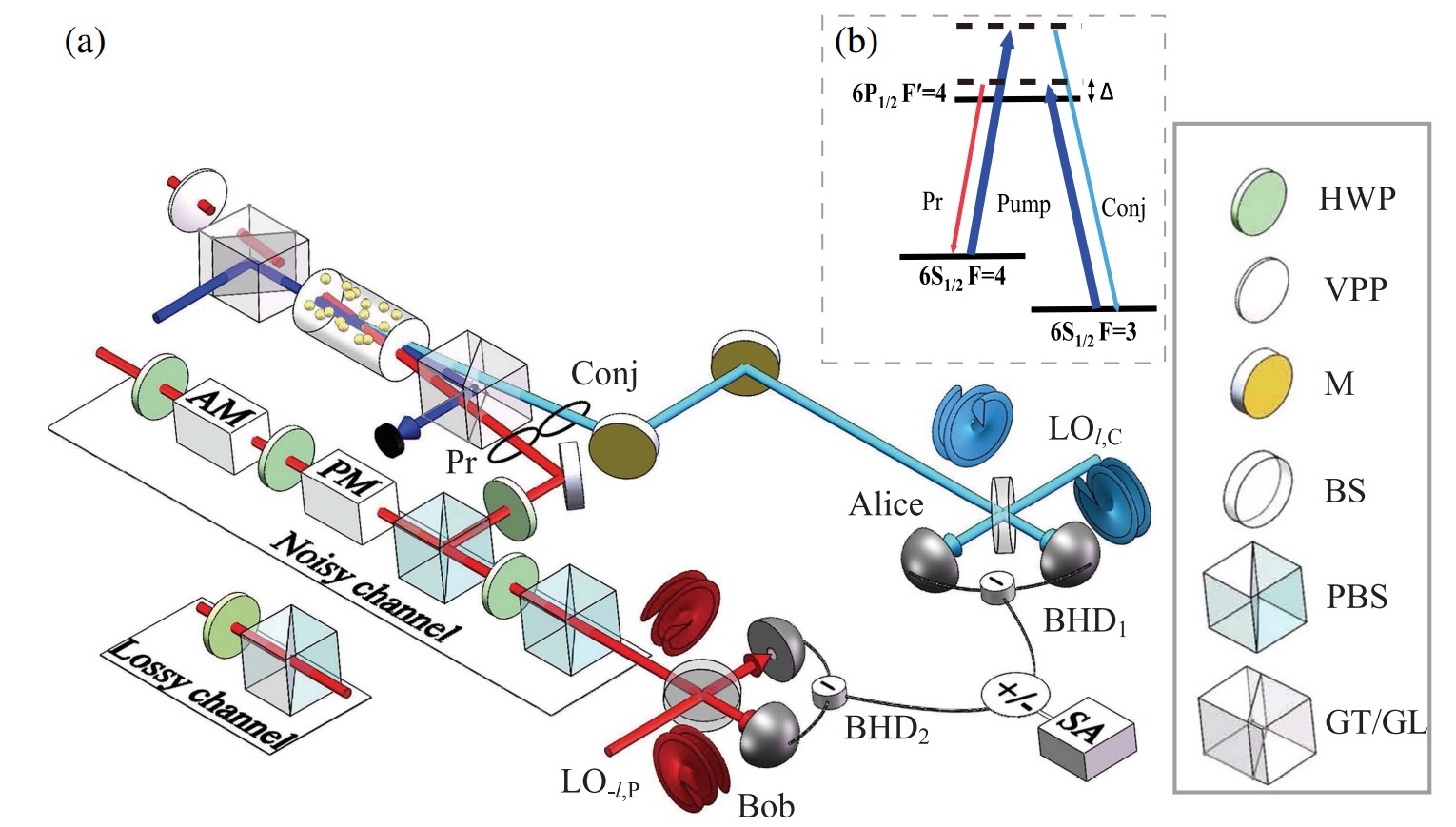
Deterministic distribution of orbital angular momentum multiplexed continuous-variable entanglement and quantum steering
Authors:Li Zeng, Rong Ma, Hong Wen, Meihong Wang, Jun Liu, Zhongzhong Qin and Xiaolong Su
Orbital angular momentum (OAM) multiplexing provides an efficient method to improve data-carrying capacity in various quantum communication protocols. It is a precondition to distribute OAM multiplexed quantum resources in quantum channels for implementing quantum communication. However, quantum steering of OAM multiplexed optical fields and the effect of channel noise on OAM multiplexed quantum resources remain unclear. Here, we generate OAM multiplexed continuous-variable (CV) entangled states and distribute them in lossy or noisy channels. We show that the decoherence property of entanglement and quantum steering of the OAM multiplexed states carrying topological charges l 1 and l 2 are the same as that of the Gaussian mode with l 0 in lossy and noisy channels. The sudden death of entanglement and quantum steering of high-order OAM multiplexed states is observed in the presence of excess noise. Our results demonstrate the feasibility to realize high data-carrying capacity quantum information processing by utilizing OAM multiplexed CV entangled states.
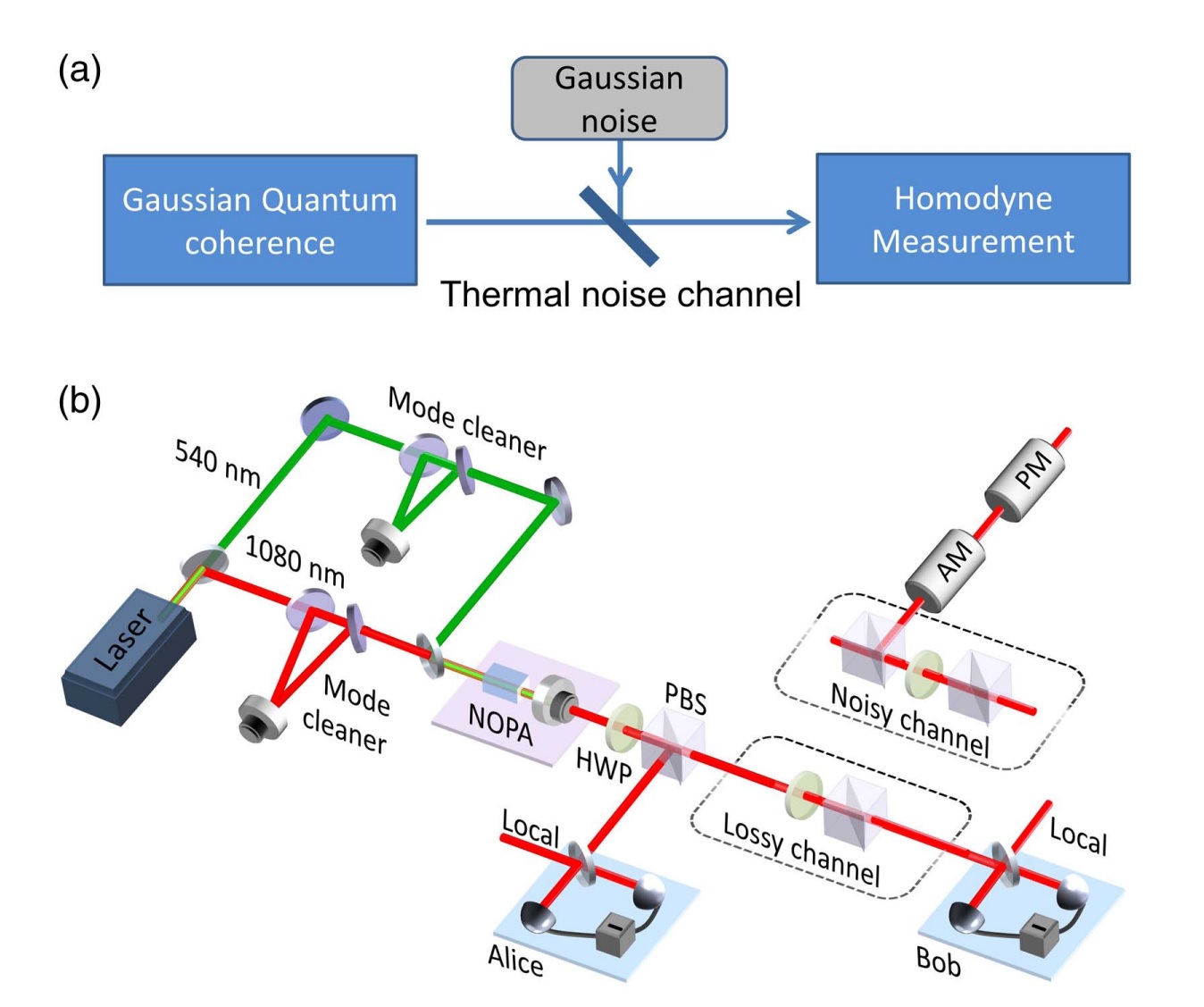
Experimental demonstration of robustness of Gaussian quantum coherence
Authors:Haijun Kang, Dongmei Han, Na Wang, Yang Liu, Shuhong Hao & Xiaolong Su
Besides quantum entanglement and steering, quantum coherence has also been identified as a useful quantum resource in quantum information. It is important to investigate the evolution of quantum coherence in practical quantum channels. In this paper, we experimentally quantify the quantum coherence of a squeezed state and a Gaussian Einstein–Podolsky–Rosen (EPR) entangled state transmitted in Gaussian thermal noise channel. By reconstructing the covariance matrix of the transmitted states, quantum coherence of these Gaussian states is quantified by calculating the relative entropy. We show that quantum coherence of the squeezed state and the Gaussian EPR entangled state is robust against loss and noise in a quantum channel, which is different from the properties of squeezing and Gaussian entanglement. Our experimental results pave the way for application of Gaussian quantum coherence in lossy and noisy environments.

Quantifying quantum coherence of optical cat states
Authors:Miao Zhang, Haijun Kang, Meihong Wang, Fengyi Xu, Xiaolong Su , and Kunchi Peng
The optical cat state plays an essential role in quantum computation and quantum metrology. Here, we experimentally quantify quantum coherence of an optical cat state by means of relative entropy and the l 1 norm of coherence in a Fock basis based on the prepared optical cat state at the rubidium D1 line. By transmitting the optical cat state through a lossy channel, we also demonstrate the robustness of quantum coherence of the optical cat state in the presence of loss, which is different from the decoherence properties of fidelity and Wigner function negativity of the optical cat state. Our results confirm that quantum coherence of optical cat states is robust against loss and pave the way for the application of optical cat states.

Sudden death and revival of Gaussian Einstein-Podolsky-Rosen steering in noisy channels
Authors:Xiaowei Deng, Yang Liu, Meihong Wang, Xiaolong Su, and Kunchi Peng
Einstein–Podolsky–Rosen (EPR) steering is a useful resource for secure quantum information tasks. It is crucial to investigate the effect of inevitable loss and noise in quantum channels on EPR steering. We analyze and experimentally demonstrate the influence of purity of quantum states and excess noise on Gaussian EPR steering by distributing a two-mode squeezed state through lossy and noisy channels, respectively. We show that the impurity of state never leads to sudden death of Gaussian EPR steering, but the noise in quantum channel can. Then we revive the disappeared Gaussian EPR steering by establishing a correlated noisy channel. Different from entanglement, the sudden death and revival of Gaussian EPR steering are directional. Our result confirms that EPR steering criteria proposed by Reid and I. Kogias et al. are equivalent in our case. The presented results pave way for asymmetric quantum information processing exploiting Gaussian EPR steering in noisy environment.
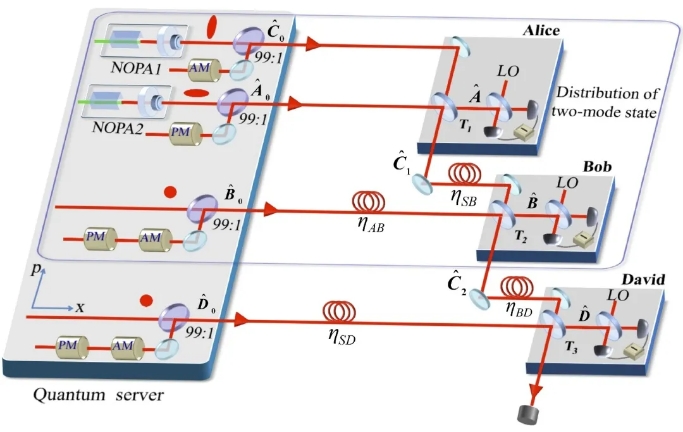
Deterministic Distribution of Multipartite Entanglement and Steering in a Quantum Network by Separable States
Authors:Meihong Wang, Yu Xiang, Haijun Kang, Dongmei Han, Yang Liu, Qiongyi He, Qihuang Gong, Xiaolong Su , and Kunchi Peng
As two valuable quantum resources, Einstein-Podolsky-Rosen entanglement and steering play important roles in quantum-enhanced communication protocols. Distributing such quantum resources among multiple remote users in a network is a crucial precondition underlying various quantum tasks. We experimentally demonstrate the deterministic distribution of two- and three-mode Gaussian entanglement and steering by transmitting separable states in a network consisting of a quantum server and multiple users. In our experiment, entangled states are not prepared solely by the quantum server, but are created
among independent users during the distribution process. More specifically, the quantum server prepares separable squeezed states and applies classical displacements on them before spreading out, and users simply perform local beam-splitter operations and homodyne measurements after they receive separable states.We show that the distributed Gaussian entanglement and steerability are robust against channel loss. Furthermore, one-way Gaussian steering is achieved among users that is useful for further directional or highly asymmetric quantum information processing.
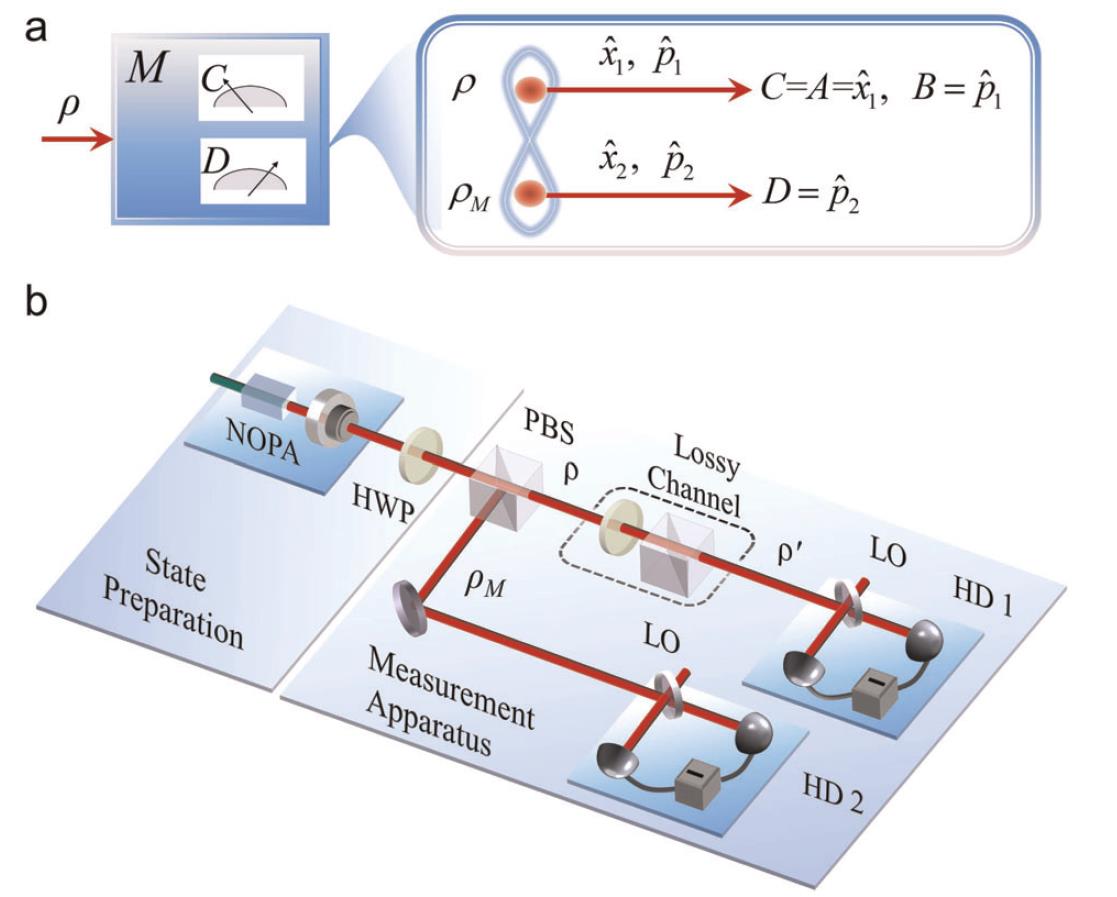
Experimental test of error-tradeoff uncertainty relation using a continuous-variable entangled state
Authors:Yang Liu, Zhihao Ma, Haijun Kang, Dongmei Han, Meihong Wang, Zhongzhong Qin, Xiaolong Su, and Kunchi Peng
Yang Liu, Zhihao Ma, Haijun Kang, Dongmei Han, Meihong Wang, Zhongzhong Qin, Xiaolong Su, and Kunchi Peng
Heisenberg’s original uncertainty relation is related to measurement effect, which is different from the preparation uncertainty relation. However, it has been shown that Heisenberg’s error disturbance uncertainty relation is not valid in some cases. We experimentally test the error-tradeoff uncertainty relation by using a continuous-variable Gaussian Einstein–Podolsky–Rosen (EPR)-entangled state. Based on the quantum correlation between the two entangled optical beams, the errors on amplitude and phase quadratures of one EPR optical beam coming from joint measurement are estimated, respectively, which are used to verify the error–tradeoff relation. Especially, the error–tradeoff relation for error-free measurement of one observable is verified in our experiment. We also verify the error–tradeoff relations for nonzero errors and mixed state by introducing loss on one EPR beam. Our experimental results demonstrate that Heisenberg’s error–tradeoff relation is violated in some cases for a continuous-variable system, while the Ozawa’s and Branciard’s relations are valid.
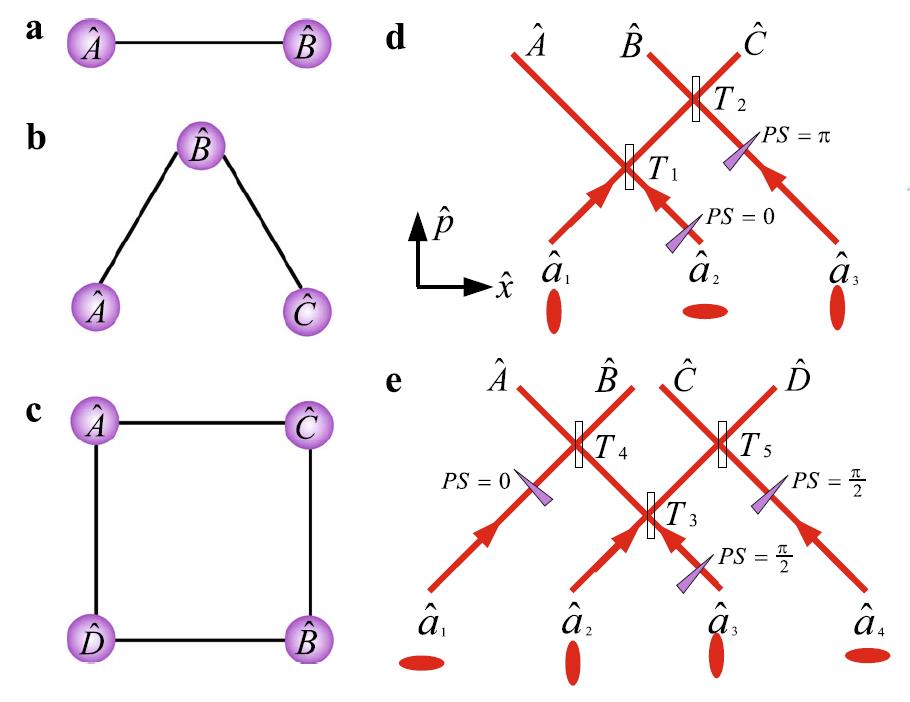
Characterizing the multipartite continuous-variable entanglement structure from squeezing coefficients and the Fisher information
Authors:Zhongzhong Qin, Manuel Gessner, Zhihong Ren, Xiaowei Deng, Dongmei Han, Weidong Li, Xiaolong Su, Augusto Smerzi, and Kunchi Peng
Zhongzhong Qin, Manuel Gessner, Zhihong Ren, Xiaowei Deng, Dongmei Han, Weidong Li, Xiaolong Su, Augusto Smerzi, and Kunchi Peng
Understanding the distribution of quantum entanglement over many parties is a fundamental challenge of quantum physics and is of practical relevance for several applications in the field of quantum information. The Fisher information is widely used in quantum metrology since it is related to the quantum gain in metrology measurements. Here, we use methods from quantum metrology to microscopically characterize the entanglement structure of multimode continuous-variable states in all possible multi-partitions and in all reduced distributions. From experimentally measured covariance matrices of Gaussian states with 2, 3, and 4 photonic modes with controllable losses, we extract the metrological sensitivity as well as an upper separability bound for each partition. An entanglement witness is constructed by comparing the two quantities. Our analysis demonstrates the usefulness of these methods for continuous-variable systems and provides a detailed geometric understanding of the robustness of cluster-state entanglement under photon losses.
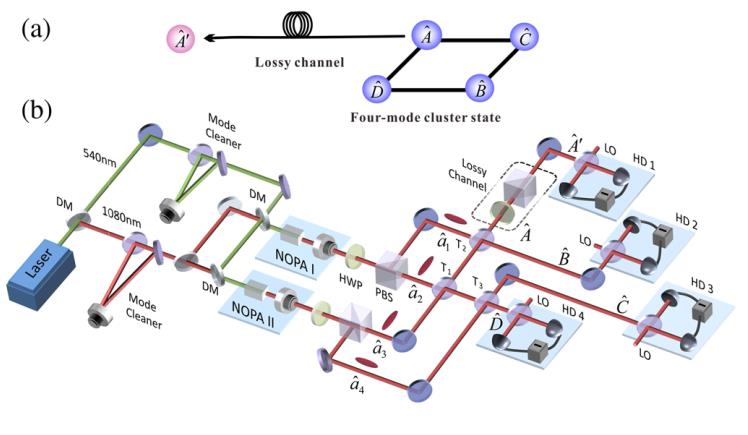
Demonstration of Monogamy Relations for Einstein-Podolsky-Rosen Steering in Gaussian Cluster States
Authors:Xiaowei Deng, Yu Xiang, Caixing Tian, Gerardo Adesso, Qiongyi He, Qihuang Gong, Xiaolong Su, Changde Xie, and Kunchi Peng
Xiaowei Deng, Yu Xiang, Caixing Tian, Gerardo Adesso, Qiongyi He, Qihuang Gong, Xiaolong Su, Changde Xie, and Kunchi Peng
Understanding how quantum resources can be quantified and distributed over many parties has profound applications in quantum communication. As one of the most intriguing features of quantum mechanics, Einstein-Podolsky-Rosen (EPR) steering is a useful resource for secure quantum networks. By reconstructing the covariance matrix of a continuous variable four-mode square Gaussian cluster state subject to asymmetric loss, we quantify the amount of bipartite steering with a variable number of modes per party, and verify recently introduced monogamy relations for Gaussian steerability, which establish quantitative constraints on the security of information shared among different parties. We observe a very rich structure for the steering distribution, and demonstrate one-way EPR steering of the cluster state under Gaussian measurements, as well as one-to-multimode steering. Our experiment paves the way for exploiting EPR steering in Gaussian cluster states as a valuable resource for multiparty quantum information tasks.

